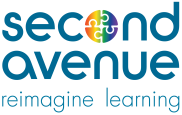Reimagine Learning
Redefining User Experience (UX): Our Top Takeaway from the NMC Conference 2017
Second Avenue Learning’s team was happy to sponsor last week’s New Media Consortium Conference, which took place in Boston, Massachusetts. The NMC is an international community of educational technology practitioners and visionaries who are shaping the future of learning in Higher Education, Adult and Career and Technical Education, as well as in K-12 schools.
Richard Culatta, CEO of the International Society for Technology in Education (ISTE), served as a keynote speaker, who tasked attendees with reexamining user experience (UX) within the education space, not just in terms of education technology’s UX but also in terms of how we define UX within educational institutions themselves.
The Three Pillars of User Experience:
The three pillars of user experience are: the user; the user’s expectation of his or her experience; and the user’s interaction with that . Culatta proposed that the challenges that we are experiencing in the education space are indicators of a UX problem—that we have not yet thoroughly identified our users and their needs; we have not yet understood our users’ expectations of their experiences; and we have not yet fully evaluated our users’ interactions with their experiences.
Culatta noted in his keynote that:
- More than 40% of students that start a 4-degree program do not finish after 6 years.
- 31 million students have started college but have not finished over the last two decades.
- Tuition and fees have increased 51% over the last 10 years.
- Textbook prices have climbed 1041% since 1994.
Education’s user is a working or a student enrolled in a blended learning course; a user’s expectation is career readiness and job security rather than a diploma; and a user’s interaction with their educational institution needs to be supported by an experience tailored to his or her specific needs. As our userbase broadens, our users’ expectations change and the ways in which they interact with their educational institution must change in order to meet their needs.
At NMC, we saw examples of schools and universities who have implemented their own process to profile their student populations, evaluate their users’ expectations of their experiences, and then examine their interactions with their institutions. Georgia State University and College for America at Southern New Hampshire University (SNHU) have captured their students’ feedback and implemented programs aligned to their students’ needs, resulting in reduced dropout rates and a higher level of jobs secured for graduates. These institutions (and others) are driving market research to guide their decisions so that they can create innovative experiences that seamlessly integrate their learners’ individual needs into their course design, their technology infrastructure, and their brick-and-mortar environments themselves.
At NMC, Second Avenue Learning’s team saw firsthand how innovation can be celebrated, not simply for innovation alone but for the substantial impact innovation can have on learners of all levels when implemented effectively. The process that institutions have started to implement models the process that we have built internally to support our partnership model with our clients and our product design process. At Second Avenue Learning, we believe that creating innovative and effective learning experiences starts with understanding our users. This is why we conduct our own research on educational practices and pedagogy and why we have created a community of subject matter experts at all levels to support our product design process; both our research and our team guide our product design process from the start so that we jointly marry our expertise with the market research that our partners conduct on their users and their own UX. By partnering together on our strategies, we can help our partners develop their product strategies and create truly innovative learning experiences, and improve their students’ outcomes, all the while growing their market share in a much more impactful and meaningful way.
At NMC, we featured our product Martha Madison, a game-based STEM curricula funded in partnership with the National Science Foundation. Martha Madison is an example of how strong user research can effectively improve student outcomes; through our market research, our iterative product design process, and our continuous user feedback program called the Gamechangers Community, we have been able to show that we can close 95% of the STEM affiliation gap by minority and economically-disadvantaged students in comparison to their majority peers.
Our top takeaway from NMC is that we can collectively design the future of education in a way which will impact students throughout the course of their life (before, during, and after graduation), if we work collaboratively and consistently to redefine education’s user.
Categories
- Accessibility (5)
- Blog (47)
- E-Learning and Serious Games (16)
- Election Edge (3)
- Guest Blogger (1)
- Learning Design (11)
- News (6)
- Primary Sources (4)
- Remote Learning (3)
- Second Avenue Voices (13)
- Teacher Tools (10)
- Technology (4)
- Uncategorized (9)
- Webinar (11)

